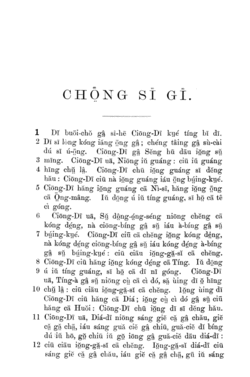Jian'ou dialect
| Jian'ou | |
|---|---|
| Gṳ̿ing-é-dī / 建甌事 | |
| Pronunciation | [kuiŋ˧ ɪ˥˦ ti˦] |
| Native to | Southern Fujian province |
Early forms | |
Chinese character, Kienning Colloquial Romanized | |
| Language codes | |
| ISO 639-3 | – |
| Glottolog | jian1240 |
| Jian'ou dialect | |
|---|---|
Hanyu Pinyin | Jiàn'ōuhuà |
| Transcriptions | |
|---|---|
| Northern Min | |
| Jian'ou Romanized | Gṳ̿ing-é-dī (IPA: [kuiŋ˧ ɪ˥˦ ti˦]) |

The Jian'ou dialect (Northern Min: Gṳ̿ing-é-dī / 建甌事; Chinese: simplified Chinese: 建瓯话; traditional Chinese: 建甌話; pinyin: Jiàn'ōuhuà), also known as Kienow dialect, is a local dialect of Northern Min Chinese spoken in Jian'ou in northern Fujian province. It is regarded as the standard common language in Jian'ou.
Phonetics and phonology
According to The Eight Tones of Kien-chou (建州八音), a rime dictionary published in 1795, the Jian'ou dialect had 15 initials, 34 rimes and 7 tones in the 18th century, however there are only 6 tones in the modern dialect as the "light level" (陽平) tone has disappeared.
Initials
| Bilabial | Alveolar | Velar | Glottal | ||
|---|---|---|---|---|---|
Nasal
|
m | n
|
ŋ | ||
Plosive
|
unaspirated
|
p | t
|
k | ʔ |
| voiceless aspirated | pʰ | tʰ | kʰ | ||
Affricate
|
voiceless unaspirated | ts | |||
| voiceless aspirated | tsʰ | ||||
Fricative
|
s | x | |||
Approximant
|
l
|
||||
Rimes
| Open syllable | Nasal coda | |||||||||||||||
|---|---|---|---|---|---|---|---|---|---|---|---|---|---|---|---|---|
| Open mouth | a | e[4] | ɛ | œ | ɔ | o[5] | ai | au | aŋ | aiŋ | eiŋ | œyŋ | ɔŋ [6] | |||
| Even mouth | i | ia | iɛ | iɔ | iau | iu | iŋ | iaŋ | ieiŋ[7] | iɔŋ | ||||||
| Closed mouth | u | ua | uɛ [8] | uai | uiŋ [9] | uaŋ | uaiŋ | uɔŋ | ||||||||
| Round mouth | y | yɛ [8] | yiŋ [9] | |||||||||||||
Tones
Jian'ou has four tones, which are reduced to two in checked syllables.
| Tone number | Tone name | Tone contour |
|---|---|---|
| 1 | level (平聲) | ˥˦ (54) or ˥ (5) |
| 2 | rising (上聲) | ˨˩ (21) or ˩ (1) |
| 3 | dark departing (陰去) | ˨ (2) |
| 4 | light departing (陽去) | ˦ (4) |
| 5 | dark entering (陰入) | ˨˦ (24) |
| 6 | light entering (陽入) | ˦˨ (42) |
The entering tones in the Jian'ou dialect do not have any entering tone coda (入聲韻尾) such as /-ʔ/, /-p̚/, /-t̚/ and /-k̚/ which makes it distinct from many other Chinese varieties.
Notes
References
- JSTOR 2718766
- ISBN 978-0-7748-0192-8
- from the original on 2023-10-13. Retrieved 2023-10-13.
- ^ /e/ tends to merge to [ɪ]
- ^ /o/ tends to merge to [ʊ]
- ^ /oŋ/ which is mentioned in Kienning Colloquial Romanized has merged into /ɔŋ/ in the modern dialect.
- ^ /ieiŋ/ is not mentioned in Kienning Colloquial Romanized as it diverged from /iŋ/ after the romanization system was established.
- ^ a b /yɛ/ tends to merge into /uɛ/.
- ^ a b /yiŋ/ tends to merge into /uiŋ/.
Sources
- Beijing daxue Zhongguo yuyan wenxue xi yuyanxue jiaoyanshi 北京大學中國語言文學系語言學教研室 (1989). Hànyǔ fāngyīn zìhuì 漢語方音字匯 (in Chinese). Beijing: Wenzi gaige chubanshe.
- Yuan, Jiahua 袁家驊 (1989). Hànyǔ fāngyán gàiyào 漢語方言概要 [An Introduction to Chinese Dialects] (in Chinese). Beijing: Wenzi gaige chubanshe.
- Jianou Xian difangzhi bianzuan weiyuanhui 建瓯县地方志编纂委员会 (1994). Jiànōu xiànzhì 建瓯县志 [Chorography of Jian'ou County]. Vol. 36. Beijing: ISBN 7-101-01283-3. Archived from the originalon 2018-04-07. Retrieved 2018-04-06.
- Lien, Chinfa (1990). "Competing Final Systems in the Jian'ou Dialect" (PDF). Tsing Hua Journal of Chinese Studies. 20 (1): 1–53.
- ISBN 0-521-29653-6.

